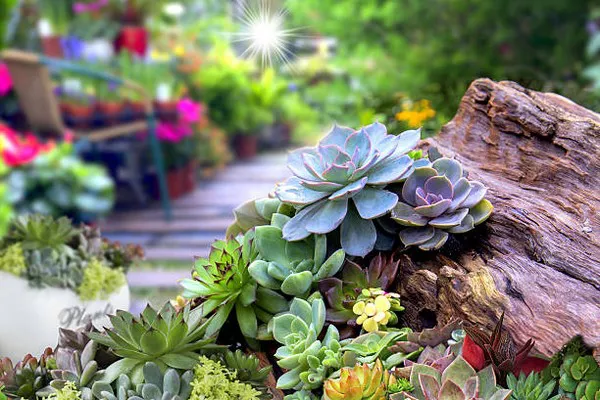Succulents, with their diverse shapes and colors, have become increasingly popular among plant enthusiasts. However, cultivating these unique plants indoors can pose challenges, especially when it comes to providing adequate light. In this comprehensive guide, we will explore the benefits of using grow lights for succulents, offering valuable insights, tips, and techniques to ensure your succulent collection thrives in an indoor environment.
Understanding the Light Needs of Succulents
Succulents, characterized by their fleshy leaves and ability to store water, have evolved to thrive in arid environments with ample sunlight. When growing succulents indoors, replicating the natural light conditions becomes crucial for their well-being. Insufficient light can lead to stretched and etiolated growth, causing succulents to lose their characteristic compact form.
To address this challenge, many succulent enthusiasts turn to grow lights. These artificial light sources are designed to provide the necessary spectrum and intensity of light, mimicking the sun’s rays and ensuring optimal growth for succulents, even in indoor settings.
Choosing the Right Grow Lights for Succulents
Selecting the appropriate grow lights is a critical step in successfully cultivating succulents indoors. LED (Light Emitting Diode) grow lights are a popular choice among indoor gardeners for their energy efficiency and ability to produce the specific light wavelengths that benefit plant growth. When choosing LED grow lights for succulents, look for those with a spectrum that includes blue and red light, as these wavelengths are essential for photosynthesis and overall plant development.
Full-spectrum LED grow lights are particularly beneficial, as they closely mimic natural sunlight, providing a balanced spectrum that supports all stages of succulent growth. Additionally, consider the intensity of the light emitted, measured in lumens or lux. Succulents generally require high light levels, so aim for a light intensity of at least 2000 lumens per square foot for optimal results.
Understanding Light Duration for Succulents
In their natural habitat, succulents receive long hours of sunlight, and replicating this photoperiod indoors is crucial for their health. On average, succulents require 12 to 14 hours of light per day to thrive. To achieve this, use a timer to automate the lighting schedule for your succulents. Consistency in light duration helps mimic the natural conditions that encourage robust growth and vibrant colors in succulents.
Positioning Grow Lights for Succulents
Proper placement of grow lights is essential to ensure uniform light distribution and prevent uneven growth patterns in succulents. Position the lights directly above the succulents, maintaining an optimal distance to avoid burning or stressing the plants. Generally, keeping the lights 12 to 18 inches above the succulents is a good starting point. Monitor the plants for signs of stress, such as color changes or elongated growth, and adjust the light distance accordingly.
Rotating succulents regularly is another effective strategy to promote even exposure to light. This prevents one side of the plant from receiving more light than the other, resulting in balanced and symmetrical growth.
See Also: How to plant succulent in pot without drainage?
Supplementing Natural Light with Grow Lights
While grow lights are essential for indoor succulent care, they can also complement natural light sources. Place succulents near windows where they can receive indirect sunlight, and use grow lights to supplement during periods of low natural light, such as winter months. This combination ensures that succulents receive a consistent and balanced light supply year-round, promoting healthy growth and vibrant colors.
Customizing Light for Different Succulent Types
Succulents come in various shapes and sizes, and their light requirements can vary accordingly. Tailoring your grow light setup to the specific needs of your succulent collection is crucial for optimal results. High-light succulents, such as echeverias and sedums, benefit from intense light levels, while low-light succulents, like haworthias and gasterias, can thrive with slightly lower light intensity.
Create zones with varying light levels based on the succulent types in your collection. This allows you to accommodate the diverse light preferences of different species and ensure each succulent receives the appropriate amount of light for its optimal growth.
Monitoring and Adjusting Light Conditions
Consistent monitoring of light conditions is key to the success of your indoor succulent garden. Keep an eye on the color, size, and overall appearance of your succulents. If you notice elongated growth, pale colors, or etiolation, it may indicate insufficient light. Conversely, signs of scorching or discoloration may suggest excessive light exposure.
Adjust the light duration, intensity, or distance accordingly to address any issues. Regularly rotating succulents and rearranging your grow light setup can help maintain uniform growth and prevent specific areas from becoming shaded.
Seasonal Adjustments for Succulent Lighting
Succulents, like many plants, experience natural growth cycles influenced by seasonal changes. As the seasons shift, consider making adjustments to your grow light setup. Increase the light duration during the winter months when natural sunlight is limited, and decrease it during the summer when days are longer. Additionally, be mindful of temperature changes, as succulents may have altered light requirements during periods of extreme heat or cold.
Conclusion
Successfully using grow lights for succulents involves a thoughtful approach that considers the unique needs of these resilient plants. By understanding the light requirements of succulents, choosing the right grow lights, and customizing your setup based on the types of succulents in your collection, you can create an indoor oasis that showcases the beauty and diversity of these captivating plants.
Consistent monitoring, seasonal adjustments, and attention to detail will ensure that your succulents not only survive but thrive under artificial lighting. With the right knowledge and techniques, you can enjoy a flourishing succulent collection indoors, no matter the season or environmental conditions.


